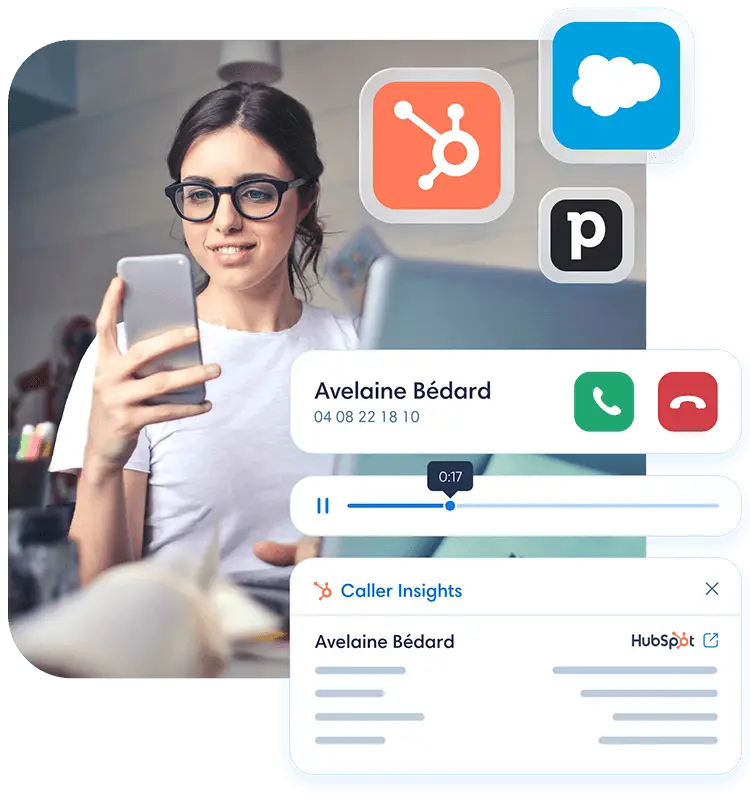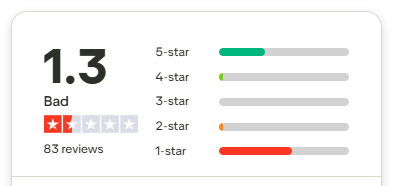You’re looking for a reliable Plivo review for your business telephony. You look at the customer feedback: Voice/SMS API and global reach on the one hand, uneven support, bugs and fuzzy pricing on the other.
We put features, call quality and costs into perspective, then compare Plivo to other vendors like Kavkom to help you decide.

Plivo is a communications API platform designed to integrate voice, SMS and WhatsApp into applications. It is aimed primarily at tech teams, SaaS publishers and scale-ups who want a programmable telecom brick, with coverage in 190+ countries and data centers in Europe, North America and Asia-Pacific.
On the product side, we offer full voice and SMS APIs (incoming/outgoing calls, conferencing, programmable routing), voicemail with transcription, queues and recordings, as well as real-time analytics. Current integrations: Salesforce, Zendesk, HubSpot, Pipedrive, Zapier. Security: TLS and SRTP encryption, encrypted data at rest, RGPD compliance possible with EU residency.
Opinions are mixed: many praise the reliability and scalability, and the documentation and support are considered good in most cases. However, there are a number of recurring issues: occasional SMS bugs, sometimes confusing documentation, pricing not always easy to read, sometimes slow support.
Rates
Positioning: Plivo is suitable if you want to control everything via API and build your own call or messaging logic. Kavkom is a turnkey solution for SMEs and call centers: PBX, webphone, mobile apps, native CRM integrations, predictive dialer and non-binding French-speaking support.
For those looking for greater flexibility or more human support, solutions like Kavkom are clearly worth considering.
In use, Plivo impresses with comprehensive, stable voice/SMS APIs, broad global coverage and correct call quality over a reliable network. Integration is simple, analytics are helpful, and the platform scales smoothly.
Limitations: occasional SMS bugs (encoding, delivery), unclear pricing, uneven documentation, sometimes slow support, no MMS and a few problems with numbers. Some teams may prefer a more turnkey solution, such as Kavkom. Here, in brief, are its strengths and weaknesses.
✅ Comprehensive voice and SMS APIs, fast integration for dev teams
✅ Global coverage 190+ countries and varied number types
✅ Solid scalability with data centers Europe, North America, APAC
✅ TLS/SRTP encryption and EU data residency, RGPD compliant
✅ Real-time analytics and exports to drive flows
✅ Pay-as-you-go model possible, useful for variable volumes
❌ Reported SMS bugs (UTF-8, delivery) and no MMS
❌ Uneven support depending on returns, sometimes long delays
❌ Unreadable and unpublished pricing; at Kavkom, public and unlimited prices from €30
❌ Variable documentation, longer integration for some teams
❌ Little public information on SLA and incident status; Kavkom communicates clear offers and commitments
❌ Limited onboarding : no assisted migration or training included, where Kavkom accompanies in French
❌ API-first approach: no turnkey PBX or ready-to-use dialer as with Kavkom

Kavkom addresses several of Plivo’s limitations with a turnkey solution. You get a ready-to-use cloud PBX and predictive dialer, with public and unlimited prices starting at €30, with no commitment and prorated. Reactive French-speaking support with configuration assistance and training. Native CRM and open API integrations, all RGPD and secure.
✅ Public rates, unlimited from €30
✅ Accompanied onboarding in French
✅ Ready-to-use cloud PBX and dialer
✅ Native CRM integrations, rapid deployment
✅ Responsive human support
No credit card
No obligation
Custom demo


Imagine you run a multi-site sales or support team. You’re looking for cloud telephony to call, text, integrate your tools, and hold the load 24 hours a day. Plivo sounds serious. But before we go any further, here’s what our customers have to say. We sifted through reviews published on Google, Trustpilot and Capterra.
Feedback is mixed, with a slight positive slant. The most common strengths are: perceived reliability, global reach, easy-to-integrate voice and SMS APIs, and good scalability. Several customers cite the platform’s stability, and support that is often helpful when it responds quickly. On the irritating side, we see recurring technical bugs on the SMS part and number management, sometimes confusing documentation, and pricing deemed difficult to read for some.
“Voice and SMS API integration was easy, call quality and very good scalability. Customer support has been better than expected.” – Capterra
“Robust platform for our 24/7 infrastructure. Despite a few bugs, the platform is stable and support is generally present.” – Trustpilot
“Unavailable customer support and recurring bugs, especially with number management. ” – Trustpilot
In concrete terms, if your team is growing fast or working across several time zones, this feedback suggests a solid, scalable technical base. Set aside time to test edge cases on SMS and numbers, and formalize exchanges with support to avoid bottlenecks in production.
Reviews point to rather competitive pricing, with a flexible model. Some appreciate the absence of long contracts. Others speak of confused pricing and difficulties in anticipating real costs, especially when bugs affect message deliverability. No reviews cite specific amounts or tiers by company size.
“Well-documented and competitively priced APIs.” – Capterra
“Unclear pricing and bugs.” – Trustpilot/Google (translated from English)
Operationally, this means two things. One, the bill can be kept in line if your usage is standard. Two, if you depend on SMS or a mix of voice and messaging in several countries, consumption monitoring must be tight to avoid discrepancies. When it comes to scalability, the opinions we get are all about the ability to go to scale. But if you reduce the number of users or change usage along the way, be sure to anticipate a budget recalibration, as the readability of the grids is a sensitive point in the feedback.
Users praise the powerful APIs for voice and SMS, simple integration into existing applications, and generally good call quality. For a manager, this means that your technical teams can connect the infra telecom to your internal tools without multiplying workarounds. This is useful if you already have an in-house CRM or specific workflows.
“Their APIs are powerful and scalable, and when support is needed, the team responds quickly and effectively.” – Trustpilot (translated from English)
“The API is powerful but the documentation is not always clear, which makes integration more time-consuming.” – Google
Limitations mainly concern messaging: problematic UTF-8 encoding and absence of MMS for certain uses. For a sales team sending out multi-channel campaigns, this can generate support tickets and manual rework. As far as training is concerned, the feedback does not detail coaching or call recording functions, so it’s difficult to assess team management support on the basis of opinions alone. The overall impression remains that of a robust technical brick, especially via the API, but this needs to be better documented.
The reviews analyzed do not directly mention security or security incidents. They talk mainly about stability, reliability, and functional bugs on SMS and numbers. There are no explicit references to MFA, SSO or advanced security controls.
“The platform is stable and support is generally present.” – Trustpilot
For you, this means that customer perception focuses on service availability and support. If security is a key criterion, you’ll need to ask the vendor targeted questions, as the reviews don’t provide any concrete evidence on this point.
Reviews mention few native dashboards, so you’ll need to check the availability of exports and real-time metrics. The only recurring theme is the API used as a lever for integration and automation, which can feed your own internal dashboards. One user mentions 24/7 operation, implying continuous operational monitoring on the customer side, but with no details on native management tools.
“Continuous use with 24/7 monitoring… the platform is stable.” – Trustpilot
In practice, if your management is based on standardized call KPIs, the reviews neither confirm nor contradict the existence of ready-to-use reporting modules. Prepare a data-driven POC to check the granularity of stats, the freshness of metrics, and the effort involved in exporting via API if you need to feed a data warehouse.
A number of feedbacks point to the global reach, a welcome feature for international deployments. On the other hand, some users cite problems with number management and associated bugs. Opinions do not go into detail about countries, number types (geographic, mobile, toll-free) or porting.
“Global reach, easy integration.” – Capterra
“Recurring problems… especially with number management.” – Trustpilot
For a multi-country company, the lesson is simple. Validate number availability in your key markets early, and test routine number lifecycle operations in pre-production. If your flows rely on frequent provisioning or massive porting, plan a test plan with edge cases to avoid service interruption.
Support is a real issue. There are some very positive experiences, with fast, efficient responses, and others much less positive, speaking of slowness and unavailability. The overall perception is therefore uneven, depending on the situation.
“Customer support has been better than expected.” – Capterra
“When support is needed, the team responds quickly and effectively. – Trustpilot (translated from English)
“Unavailable customer support and recurring bugs disrupt business.” – Trustpilot
Operationally, if your business cannot tolerate downtime, these warnings suggest that you secure your escalation processes and define clear SLAs before committing critical volumes. It may also be useful to set up an incident runbook on the support team side, so that you can stay on top of any delays in response, especially in the event of a bug in number management or SMS deliverability.
Reviews emphasize integration via API into existing voice and SMS applications. They describe the initial integration as fairly straightforward, but also point to documentation that needs to be improved, which can add to the effort. No reviews cite ready-to-use integrations with specific CRMs, or limits on functionality according to a given plan.
“Voice/SMS API integration into our application… easy integration, good call quality.” – Capterra
For an IT team, this sounds like a reliable technical foundation, provided time is allocated to reading and testing the API. For a non-technical team, the lack of specific examples of turnkey connectors in the reviews means that you’ll need to check the depth of standard integrations during the POC. If your productivity depends on contact form pop-ups, auto logs and click-to-call in your CRM, validate these points with a simple test scenario.
Based on our reviews, Plivo is ideal for teams looking for an API-first, scalable telecom brick with good stability and international reach. The expected gains mainly concern technical integration and scalability. Risks are focused on SMS messaging (encoding, deliverability), number management, pricing clarity, and variable support experience. In practice, structure your evaluation around three concrete axes:
These three tests cover the essentials, giving you a clear vision of the potential gains and risks to be anticipated.
Plivo is ideal if you’re looking for a voice/SMS API-first brick to integrate into your apps, with global coverage and scalability. Relevant for tech teams, SaaS and scale-ups who want to drive routing, automation and analytics on their own, without a ready-made PBX.
On the other hand, the limitations observed (SMS bugs, uneven documentation, unclear pricing, variable support, no MMS) are a burden for non-technical teams, call centers or organizations that require accompanied onboarding and ready-to-use functionalities.
In these cases, Kavkom offers a turnkey alternative: cloud PBX, predictive dialer, native CRM integrations, public pricing (unlimited FR/US/CA from €30), French-speaking support and rapid deployment, all while remaining RGPD with open API. A comparative test on your real workflows will quickly decide between building via API and an immediate operational solution.

Find out why over 8,000 companies work with Kavkom for their corporate telephony.
4.7 on Capterra
With Kavkom, I was able to easily resolve the issue of communication costs to my regular customers. My agents, too, were no longer restricted in their mobility, because even when on the move, communications are managed.

Ben Cauchois
VP Sales & Operations @ SEIZA
We’ve increased our targets by 10% thanks to the information we’ve gained from call identification and analysis provided by Kavkom’s telephony solution.

Dov Dahan
CEO @ Formideo
The transition to enterprise telephony in the cloud with Kavkom enables us to track KPIs to identify our strengths and weaknesses.
Arnold Panou
CEO @ VAD Assistance
We evaluated several service providers, and Kavkom emerged as the only option that allowed us to tailor our customer service requirements to our unique business practices.

Pierre Roche
Managing Partner
at Groupe OREL
The integration of Kavkom’s virtual number service with voicemail has considerably facilitated our process of collecting visitor testimonials. We have been able to gather valuable feedback that helps us to continually improve our services.

Hélène Lafont-Couturier
Visitor Relations Manager
Musée des Confluences
Please share your location to continue.
Check our help guide for more info.
